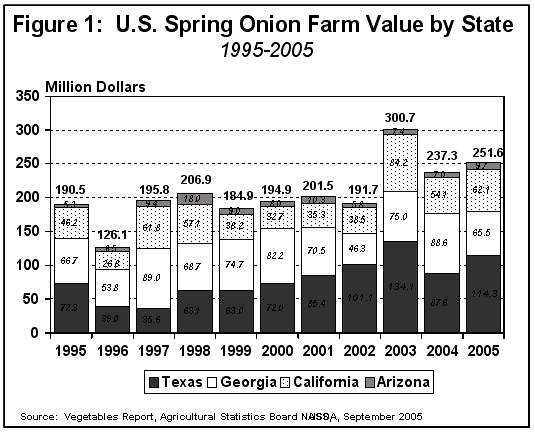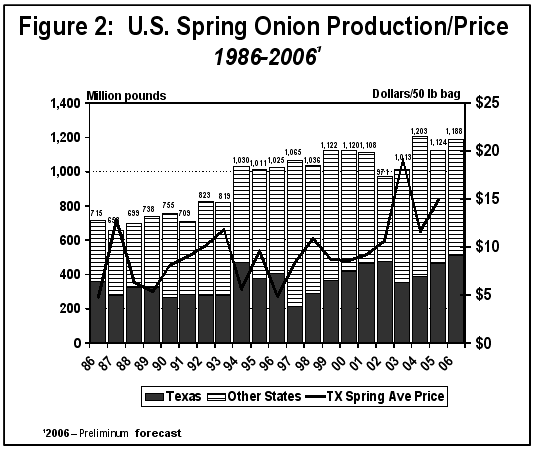AG-ECO NEWS
Vol. 22, Issue 19, June 14, 2006
Jose G. Peña
Extension Economist-Management
Spring Onion Production Economically Important to Texas
Spring onion production is very economically important to Texas. Markets have seen some improvement in recent days. While receipts from onion production in Texas in 2006 have been affected by weak markets and abundant supplies, the farm gate value of spring onion production in Texas in 2005 amounted to about $114.3 million. (See Figure 1). About 40 percent of this value came from production in the Wintergarden-Laredo region and the rest in the Lower Rio Grande Valley. This season appears similar to the 2004 season when markets weakened significantly as a result of record spring onion production. This season, while production is up, prices have weakened significantly as production costs increase significantly. The drought has increased supplemental water requirements as energy costs reach record highs. Growers are learning how to cope with a new disease problem that can threaten the crop.

According to Dr. Mark Black, Professor and Extension Plant Pathologist, Iris yellow spot virus (IYSV) has emerged in Texas as a potentially devastating and widespread virus of onion. The virus has been found in Mexico, South America and in many parts of western and southern states in the U.S. where onions are grown. In 2005, onion plants in Uvalde County, TX exhibited tan necrotic lesions on leaves typical of IYSV. The disease incidence approached 100% in some fields with yield loss and quality problems. Similar lesions were observed on onion plants in Uvalde, Hidalgo and Cameron Counties, in 2006 but a lower incidence. Infection points generally started as a single plant, near the edge of fields, and spread to plants in 3-4 meter diameter area after 1-2 weeks. Onion thrips vector IYSV. If uncontrolled, this virus will increase risk of onion losses in Texas.
The future of onion production in Texas is still good. A relative of IYSV, tomato spotted wilt virus was discovered in peanuts about 20 years ago, which threatened the peanut crop in Southwest and Central Texas. A group of county agents, scientists, agribusiness men and farmers cooperated on research and Extension adaptive research projects to address the program. Among the management tools now routinely used by growers are the use of resistant varieties developed by this team using data from plots in Frio County. The new varieties have improved yields over existing suspectable varieties even in seasons with low TSWV incidence. Scientists are optimistic that lower risk onion varieties will be identified quickly and new resistant varieties are feasible in the future.
Yield/Production Up
Yields and production are up significantly this year. The harvest in the Wintergarden of Texas peaked last Saturday (5.10.06) with 646, 40,000 pound truck load shipments and appeared to be slowing down this past week. The market opened in Texas in March to good prices of around $16/50 bag of jumbos, but the market did not hold. Prices have been weak throughout most of the harvest, especially the harvest in the Wintergarden-Laredo Region, due primarily from large production. Early estimates of spring onion production this season at 1.188 billion pound is up 5.6 percent from 1.124 billion pounds produced last year. (See Figure 2). Actual production may be higher since larger than estimated crops are being reported in Texas, Georgia and California.
 The Wintergarden region of Texas competes directly with production in Georgia and the Imperial Valley of California. Georgia produced a huge crop from increased average yields and from 3,000 more acres harvested as compared to last year. According to a feature article of the Vidalia onion crop in Georgia in the June 12, 2006 issue of The Packer, “The yields on the early onions were so heavy. . . cartons shipped as of June 3 are 22% more than volumes at the same time last year. . .” Now, up to 25% of Vidalia’s onion crop could be left in the fields as shippers switch to onions stored in cold storage during the early harvest. Shippers in Georgia are being forced to switch to locally stored spring onions as temperatures in June are reaching 95°F and threatening to bake the onions exposed in the field. Georgia is expected to be able to supply spring onions from storage through the end of September.
The Wintergarden region of Texas competes directly with production in Georgia and the Imperial Valley of California. Georgia produced a huge crop from increased average yields and from 3,000 more acres harvested as compared to last year. According to a feature article of the Vidalia onion crop in Georgia in the June 12, 2006 issue of The Packer, “The yields on the early onions were so heavy. . . cartons shipped as of June 3 are 22% more than volumes at the same time last year. . .” Now, up to 25% of Vidalia’s onion crop could be left in the fields as shippers switch to onions stored in cold storage during the early harvest. Shippers in Georgia are being forced to switch to locally stored spring onions as temperatures in June are reaching 95°F and threatening to bake the onions exposed in the field. Georgia is expected to be able to supply spring onions from storage through the end of September.
The harvest of a bumper crop is also underway in the Imperial Valley of California, but is starting to wind down. Also, New Mexico began the harvest of summer non-storage onions early and are competing with Texas, Georgia and California. As expected, prices have recently improved as supplies from the harvest in Texas, California and Georgia wind down and supplies come in balance with demand. Some expect that prices for jumbos may recover to about $16/50 lb bag in 3-4 weeks. Unfortunately, the harvest in the Wintergarden-Laredo region will be over by then.
